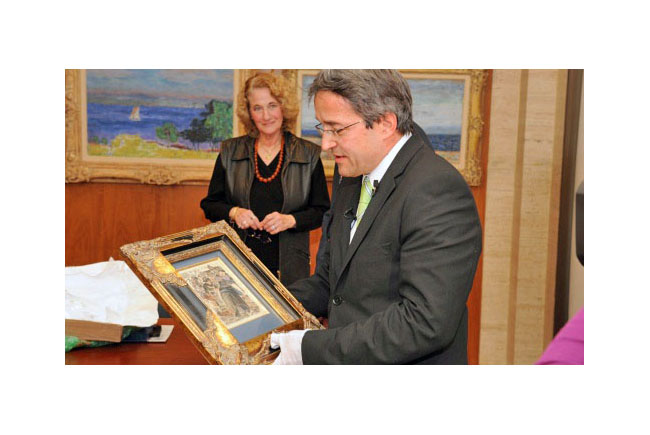Stolen Art from French Museum in 1981 is Recovered
An art piece stolen from a French museum more than 30 years ago is finally on its way home to France. U.S. officials repatriated "Le Marché aux Poissons" (The Fish Market), a monotype by Camille Pissarro, to French Ambassador François Delattre.

The monotype, which is a one-of-a-kind print made by painting on a sheet or slab of glass and transferring the still-wet painting to a sheet of paper, was stolen in 1981 by a man named Emile Guelton, who walked out of the Faure Museum in Aix-les-Bains, France, with the work under his jacket. The museum guard and another witness provided descriptions of the thief to French law enforcement authorities, but no one was apprehended.
In 1985, Guelton sold the monotype to a gallery in San Antonio, Texas, where it was immediately purchased by Sharyl Davis, a gallery employee, for $8,500. In 2003, Davis consigned the artwork to Sotheby's New York for auction, where it was expected to sell at an estimated price of $60,000 to $80,000.
Just prior to the auction, the Art Loss Register discovered the stolen work in the auction catalogue and notified Interpol. Interpol passed the information through ICE's Cultural Property, Art and Antiquities Unit to ICE's Homeland Security Investigations (HSI) office in New York. ICE HSI special agents in New York then initiated an investigation, and on Nov. 20, 2006, executed a federal seizure warrant and took possession of the monotype.
In January 2010, Davis contested the seizure in a civil trial in the Southern District of New York, and an eight-member jury voted unanimously in favor of the government. Following the appeals process, the monotype was officially forfeited to the United States on Nov. 22, 2011, in order to be repatriated to France.
"Returning this piece of art to the people of France is another great example of the ongoing work ICE HSI agents are doing to investigate the theft of cultural treasures and return them to their rightful owners," said ICE Director John Morton. "ICE's Homeland Security Investigations remains committed to combating cultural heritage crimes and righting the wrongs committed by the perpetrators of this illicit activity."
"Thanks to yet another outstanding Franco-American cooperation, Le Marché aux Poissons will be again available for museum visitors in Aix-les-Bains," said Ambassador Delattre.
"International trafficking in stolen art threatens every nation's ability to safeguard cultural treasures for future generations," said U.S. Attorney Preet Bharara for the Southern District of New York. "It is very gratifying for our office to play a role in helping this artwork find its way back home after so many years."
"The return of this one-of-a-kind, extraordinary piece of artwork to France is yet another fine example of what can be achieved when law enforcement officials work together from all around the world for a specific mission. I would like to personally acknowledge the outstanding coordination efforts between ICE HSI, the U.S. Attorney's Office for the Southern District of New York, and the staff from Interpol Washington for working diligently to return this valuable piece of art to the place where it belongs," stated Interpol Washington Director Timothy A. Williams.
ICE HSI plays a leading role in criminal investigations that involve the illicit importation and distribution of cultural property, as well as the illegal trafficking of artwork. The agency specializes in recovering works that have been reported lost or stolen. The ICE HSI Office of International Affairs, through its 71 attaché offices in 47 countries, works closely with foreign governments to conduct joint investigations, when possible.
ICE HSI specially trained investigators, assigned to both domestic and international offices, partner with governments, agencies and experts to protect cultural antiquities. They also train investigators from other nations and agencies on investigating crimes involving stolen property and art, and how to best enforce the law to recover these items when they emerge in the marketplace.
Those involved in the illicit trafficking of cultural property, art and antiquities can face prison terms of up to 20 years, fines and possible restitution to purchasers of the items.